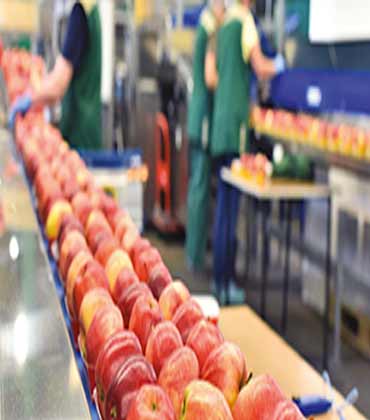THANK YOU FOR SUBSCRIBING
By Todd Jongen, Director Non-Foods Product Development and Packaging Science, US Foods
A Brief History of Carry-Out Food Packaging
By Robert Erhard, Head of Dairy, Corporate Sustainable Agricultural Development, Nestle
Transforming the Food Industry Through a Sustainable...

Driving Enterprise-Wide Food Safety through Collaboration & Empowerment
Wumi Yusuff, MS, CFS, Senior Director, Food Safety, Ferrara Candy Company

 Wumi Yusuff, MS, CFS, Senior Director, Food Safety, Ferrara Candy Company
Wumi Yusuff, MS, CFS, Senior Director, Food Safety, Ferrara Candy CompanyEnterprise-Wide Commitment to Food Safety Ownership
In today’s fast-paced and highly regulated food industry, ensuring food safety is not just the responsibility of one department, it’s a shared commitment across the entire organization. Driving food safety ownership enterprise-wide is essential for building a culture of accountability, where every team member, regardless of function, plays a vital role in upholding standards and protecting consumers.
According to the U.S. Department of Agriculture (USDA) and the Food and Drug Administration (FDA) data, food recalls in the U.S. increased by 26% between 2021 and 2023. The primary causes included undeclared allergens (47%), microbiological contamination (30%), and physical hazards such as foreign materials (10%). These figures highlight the importance of a proactive, enterprise-wide approach to food safety, ensuring that risks are identified and mitigated before they escalate into major incidents.
One of the most effective ways to achieve this is through cross-functional collaboration and empowerment. By bringing together diverse expertise from across business units such as operations, quality, food safety, maintenance, engineering, supply chain, product development, procurement, and more, organizations can foster a unified approach to identifying risks, solving challenges, and driving continuous improvement.
This collaborative approach enhances food safety practices and encourages greater ownership at all levels, from the production floor to senior leadership.
The Power of Cross-Functional Collaboration
The importance of cross-functional collaboration cannot be overstated. Breaking down silos and fostering a culture of ownership and shared responsibility enterprise-wide is key to advancing food safety initiatives. Ensuring early buy-in from stakeholders is critical to facilitating successful implementation and sustainability.
Everyone has a role to play, from the CEO to the shop floor. Establishing clear communication channels ensures a continuous feedback loop from the top down and the bottom up. Engaging, empowering, and motivating employees is integral to fostering collaboration and influencing teams to prioritize food safety.
Leadership Commitment: The Foundation of Food Safety Culture
Leadership commitment is fundamental to creating and sustaining a strong food safety culture. When leaders set the expectation that food safety is nonnegotiable, it reinforces the importance of doing the right things and doing things right. Integrating food safety into business strategy further strengthens this commitment, showing that food safety is not just a compliance requirement but an essential part of doing business successfully.
“Food safety is a shared responsibility, not just a compliance requirement. When every employee is engaged, empowered, and accountable, organizations can reduce risks, enhance consumer trust, and build a culture where food safety becomes a core business value”
In addition, providing adequate resources and capital for food safety initiatives facilitates collaboration by removing roadblocks. When financial and operational constraints are addressed, teams can focus on implementation without hesitation or doubt.
Challenges to Cross-Functional Collaboration
While collaboration is critical, certain challenges can hinder efforts to build an enterprise-wide food safety culture.
Some of these challenges include:
• Conflicting Priorities: Competing business demands may take precedence over food safety initiatives if not clearly aligned with broader organizational goals.
• Lack of Communication: Ineffective communication between departments can result in misunderstandings, misalignment, and missed opportunities for improvement.
• Limited Early Involvement: When key stakeholders are not included in the decision-making process from the start, it can lead to resistance and lack of ownership.
To overcome these challenges, organizations must ensure that every employee, regardless of their function or level, feels involved and accountable for achieving food safety goals. Building strong relationships fosters trust and enables positive influence across teams.
Strategies to Foster Collaboration, Communication, and Empowerment
To ensure alignment with food safety goals and enhance collaboration between business units, organizations can implement the following approaches:
1. Be Intentional About Stakeholder Engagement
• Understanding each department’s role in food safety before requiring their input is essential. Proactively building relationships with stakeholders strengthens collaboration when critical issues arise.
2. Establish Clear Communication Channels
• Creating structured feedback mechanisms such as regular crossfunctional meetings, food safety newsletters, employee surveys, and plant walkthroughs ensures continuous dialogue and transparency.
3. Ensure Inclusive Decision-Making
• All relevant stakeholders must have a seat at the table when discussing and prioritizing food safety initiatives. Incorporating diverse perspectives enhances strategy development and facilitates goal alignment.
4. Invest in Training and Education
• Providing ongoing food safety training ensures that all teams share a common understanding of best practices, regulatory requirements, and emerging risks. Education empowers employees to take proactive measures and make informed decisions.
5. Recognize and Reward Contributions
• Incentivizing collaboration through recognition programs and performancebased rewards reinforces the value of teamwork in achieving food safety excellence. Celebrating wins, both big and small, helps sustain motivation and commitment.
Measuring Success: Key Performance Indicators (KPIs)
To ensure food safety ownership is truly embedded into the organization, companies must track their progress through Key Performance Indicators (KPIs). These KPIs help identify gaps, assess improvements, and drive accountability.
• Cost of Poor Quality (COPQ)
• Consumer Complaints Related to Food Safety
• Right First Time (RFT) or First Pass Quality
• Employee Engagement & Culture Metrics
• Corrective Action (CAPA) closure rate
• Zero repeat pathogen hits
By integrating these KPIs into daily operations, strategic reviews, and leadership discussions, companies can ensure that food safety remains a measurable, continuous improvement priority.
Conclusion
Driving food safety ownership is not a one-time initiative, it requires continuous engagement and collaboration at all levels. By fostering a culture of accountability, investing in training, and ensuring leadership commitment, businesses can build a sustainable, proactive approach to food safety. When every employee understands their role and takes accountability, food safety becomes a shared responsibility rather than just a compliance requirement. Through teamwork, communication, and datadriven improvements, organizations can not only meet regulatory standards but also build consumer trust and protect their brands.
By working together, we can strengthen food safety systems, reduce risks, and create a culture where food safety is not just a priority, but a way of doing business.
Read Also















